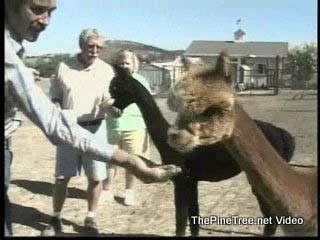
About this time, late in 2001 we stared planning for our next vacation which was a trip to Bolivia and Peru to visit our daughter Kristin, who was serving as a Peace Corps volunteer on the Alta Plano in Bolivia. It was a wonderful trip; and, we saw many alpaca in their natural habitat, in the high elevations of the Andes Mountains, between Bolivia and Peru. We of course took many pictures of huge herds of alpaca as our train slowly climbed to over 14,000 feet. We traveled across the Andes from Puno, on the shore of Lake Titicaca, to the ancient city of Cusco. In Peru, it seemed like there were alpaca everywhere we looked. Once we returned to Bolivia, our daughter recommended that we visit a store in Cochabamba that sold only alpaca garments and blankets. More seeds were being planted; but we never thought they were GROWING. Once back home again, we really didn't have any further thoughts about alpaca other than snuggling under one of the wonderfully warm blankets or wearing sweaters that we had purchased or enjoying the warm socks, we purchased on our earlier trip to San Juan Islands. But in the fall of 2002, some more seeds we PLANTED. Pam had seen an article in one of the local newspapers about a family that had started raising alpacas in the area. I can remember clearly the first thing she said after reading the article, "Read This!! This is something we can do". Seeds were clearly starting to GERMINATE.
Rick & Pam Brady began raising alpacas after visiting their daughter Kristin, who was serving as a Peace Corps volunteer on the Alta Plano in Bolivia
Talking Alpaca with Bill Vierra of Calaveras Grown. ~Produced By Paul Moeller
Valley Springs, CA...We would like to thank Bill Vierra for letting us convert some of the Classic Calaveras Grown TV shows. In this show Bill talks to Rick & Pam Brady of Oak Valley Alpacas in Valley Springs. They have a wonderful operation and their animals have won national awards. It is a fun and informative segment...
Get Microsoft Silverlight
Click To Watch Video in External Player
From the Oak Valley Alpaca website...
Where to begin? I guess it's about planting seeds…
Like many people new to alpaca breeding, if anyone would have told us that we'd be doing this two years ago, I would have thought that they were crazy. Our first introduction to these wonderful animals was on 9/11/2001 (yes, that 9/11). We were on vacation and visiting Friday Harbor in the San Juan Islands of Washington State. We stayed at a B & B where the owner had several fiber quality alpacas that she used in putting together knitting kits, made from yarn that she produced from her animals. They were, we thought, wonderful cute animals and the seed, unbeknownst to us, was PLANTED. While on San Juan Island, we also visited Crescent Moon Ranch, a large alpaca breeder located very near to where we were staying. Crescent Moon had a ranch store; and we were able to touch, feel, fondle, (and purchase) the products made from this wonderful fleece. We really didn't think too much about alpacas after the end of our vacation other than to enjoy the products that we had purchased.
About this time, late in 2001 we stared planning for our next vacation which was a trip to Bolivia and Peru to visit our daughter Kristin, who was serving as a Peace Corps volunteer on the Alta Plano in Bolivia. It was a wonderful trip; and, we saw many alpaca in their natural habitat, in the high elevations of the Andes Mountains, between Bolivia and Peru. We of course took many pictures of huge herds of alpaca as our train slowly climbed to over 14,000 feet. We traveled across the Andes from Puno, on the shore of Lake Titicaca, to the ancient city of Cusco. In Peru, it seemed like there were alpaca everywhere we looked. Once we returned to Bolivia, our daughter recommended that we visit a store in Cochabamba that sold only alpaca garments and blankets. More seeds were being planted; but we never thought they were GROWING.
Once back home again, we really didn't have any further thoughts about alpaca other than snuggling under one of the wonderfully warm blankets or wearing sweaters that we had purchased or enjoying the warm socks, we purchased on our earlier trip to San Juan Islands. But in the fall of 2002, some more seeds we PLANTED. Pam had seen an article in one of the local newspapers about a family that had started raising alpacas in the area. I can remember clearly the first thing she said after reading the article, "Read This!! This is something we can do". Seeds were clearly starting to GERMINATE.
I started a casual search of the web, ordered some information from AOBA, and began planning some of our first ranch visits. Of course, Pam was thinking of a few fiber animals. I was looking at the business potential. Pam and I were ready for a lifestyle change. After living and working in Silicon Valley for over thirty years, it was time to slow down a little or so we thought. We started visiting alpaca breeders in California and Oregon and at the same time started looking for suitable "alpaca friendly" acreage in Calaveras County in the central Sierra foothills. We had planned to combine some assets and thought it would take many months to be in a position to buy property and purchase our first animals.
Well, everything moved a lot faster than we had anticipated. We found ourselves moving into our new home in Valley Springs on May 28, 2003. We had purchased a newly constructed home on five and a quarter acres and just had to get "some fencing" up before we'd be ready to purchase our first alpacas. About three months and 1800 feet of fencing and three loafing sheds later, we were ready to start buying animals for our foundation herd. The learning curve is pretty steep when you move from the city to the country and start thinking of how to build a serviceable small farm. You learn things that you would never have thought you would ever need before moving to the country. Things like how to install and stretch roll after roll of no climb fencing. Words creep into your vocabulary like "come-along", "high-tension wire", "no-climb fencing", "spinning jenny", "gripple", "box-scraper", "free choice minerals" and the list goes on and on and on. We could have purchased our animals earlier and boarded them; but we wanted to wait until we had everything ready to go at our new farm. The fencing alone could have killed me. The whole process of getting fencing up and loafing sheds built was much more work (and expense) than I had anticipated; but it was a major sense of satisfaction when Phase One was completed. Thanks to a lot or hard work by everyone in the family and a few friends, everything was ready by the middle of September. Our seeds were SPROUTING.
I have to say, that from January of 2003 through the time that we actually received our first animals, we had visited a lot of ranches and farms ranging in size from just a few animals to ranches with hundreds of alpacas. We learned something new from each and every breeder we visited. If not about ranch layout, then about alpaca breeding, or genetics, herd health, or feed issues that must be addressed. Every breeder was very willing to share as much information with us that we could absorb. We have become good friends with many of the folks that we've met along the way. Those seeds are still GROWING and beginning to FLOWER.
The big day finally came in late September 2003. Our first five animals arrived; and I guess at that point the seeds had BLOOMED. And of course, this is just the start. We have plans for additional fencing, more loafing sheds, a barn and something for hay storage and for sure a few more animals, as our girls give birth.
As I mentioned we gained a lot of knowledge from a lot of alpaca folks, but I would be remise not to mention Richard and April Angotti of Benvenuti Farm in Bend, Oregon where we purchase our first five animals, and Mike and Carolyn Scott of Comanche Ranch Alpacas, neighbors and good friends (and fencers extraordinaire) for all their help and advice along the way. Our seeds have born FRUIT.
Sara, Our New Livestock Guard Dog
Sara came to us last fall through Great Pyrenees Rescue of Northern California. She has been a fun addition to our farm and she has a lot more energy than Titus our other LGD. Sara is still young at about two years of age and her worth as a true LGD is still undetermined. Sara gets along very well with Titus and Bailey our farm companion dog, but still likes to run with the alpacas. She never initiates a chase but if the alpacas decide that they want to run, Sara is always right there with them. Titus just lies there and watches them all go by and tries not to let them all disturb is daytime nap. Of course we discourage Sara from chasing and she always stops when she receives a sharp reprimand. Her most endearing activity is taking one of us very gently by the hand or arm (with her mouth) over to the bin where we keep the treats. While Sara gets along with all the alpacas on the ranch, the adult males seem to take great delight chasing her out of their pen. Maybe they just don’t like girl dogs.
For more information about Great Pyrenees Rescue in Northern California visit www.GPRNC.org.











